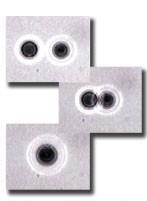Aerosol measurements are improved with optical tweezers
Aerosol measurements are improved with optical tweezers

Single aerosol droplets have been controlled using optical tweezers for the first time.
In a series of groundbreaking experiments, Jonathan Reid and colleagues from Bristol University, UK, have shown that droplets of water and decane between four and 14 micrometres in diameter can be trapped indefinitely by optical tweezers.
This is the first time the optical tweezers phenomenon, where a tightly focused laser beam is able to trap and hold tiny particles, has been used on aerosol droplets.
Aerosols play an important role in numerous scientific areas, including atmospheric chemistry. To understand them better, studies have to be made on single aerosol particles because this avoids the averaging effects that result from taking measurements on an ensemble of particles.
Motivated by this, Reid has managed to trap individual droplets using optical tweezers, and, coupled with cavity enhanced Raman scattering, has measured the droplets’ diameters to unprecedented nanometre accuracy. This makes it possible to monitor the droplet growing or evaporating with a precision that was previously unrealisable. Reid comments that the new technique can also be used to ’control multiple droplets, bringing them to a point of coalescence, potentially enabling us to mix chemicals together in extremely small volumes’.
Being able to control and examine a single droplet particle is an important breakthrough and opens the door to a wide range of new studies. Reid says: ’We can now examine the chemical and physical transformations of aerosols on a single particle basis, not only giving us key insights into fundamental processes at the gas-liquid interface but also enabling us to study complex aerosols relevant to real life situations’.
Work is continuing to measure different sized particles, and to increase the number of particles that can be trapped and manipulated simultaneously, which is currently which is limited to just two.
Philip Earis
References
R J Hopkins et al, Phys. Chem. Chem. Phys., 2004, 21, 4924 <MAN>b414459g</MAN>






No comments yet